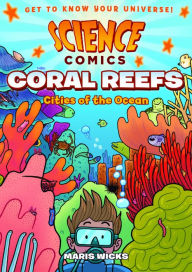In this entry in the Science Comics series, Katharine, the younger sister of Orville and Wilbur Wright, explains the science behind flight and how her brothers invented and flew the first successful airplane.The Wright brothers were not the first to try to create flying machines, nor were they alone in their era in experimenting with them. In addition to chronicling their failures and successes, the narrative discusses the work of other pioneers in heavier than air flight, such as Otto and Gustav Lilienthal and Alphonse Pénaud. Scientific concepts including Newton's laws of motion are clearly and concisely explained, as are technical components of the airplanes the Wright brothers invented and tested. Further innovations in flight are explained, ending with the invention of the jet engine. The text is informative and engagingly written, and the illustrations are colorful and appealing. A palette of brown, ocher, and blue-gray gives the graphic panels an appropriately antique feel. Unsurprisingly, they are almost exclusively populated by white people. Backmatter includes brief profiles of other aviation pioneers and a short biography of Katharine Wright. There is no bibliography or source notes and a surprising paucity of age-appropriate titles in the suggestions for further reading. An accessible and engaging introduction to the Wright brothers and how they ushered in the age of flight. (glossary, further reading) (Graphic nonfiction. 8-12)
Science Comics: Flying Machines: How the Wright Brothers Soared
Paperback
$12.99
- ISBN-13: 9781626721395
- Publisher: First Second
- Publication date: 05/23/2017
- Series: A Faith Hunter Scrap This Mystery
- Pages: 128
- Sales rank: 132,711
- Product dimensions: 6.00(w) x 8.40(h) x 0.60(d)
- Age Range: 9 - 13 Years
Eligible for FREE SHIPPING details
.
12.99
Out Of Stock
Customers Who Bought This Item Also Bought
-
- Science Comics: Rockets:…
- by David Earl WilliamsJerzy Drozd
-
- Science Comics: Robots and…
- by Mairghread ScottJacob Chabot
-
- Science Comics: The Brain: The…
- by VidargangrKronkan Sutthikoses
-
- Bats: Learning to Fly (Science…
- by D. BystrakD. Bystrak
-
- Science Comics: Solar System:…
- by best-selling author of American Sniper and The Hel Jim DeFeliceJon Chad
-
- Volcanoes: Fire and Life…
- by Jon ChadJon Chad
-
- Science Comics: Plagues: The…
- by D. BystrakD. Bystrak
-
- Coral Reefs: Cities of the…
- by Maris Wicks
-
- Science Comics Skyscrapers :…
- by John Kerschbaum
-
- Robots & Repeats (Secret…
- by Gene Luen YangMike Holmes
-
- Secret Coders: Secrets &…
- by Gene Luen YangMike Holmes
-
- The Great Art Caper
- by Victoria JamiesonVictoria Jamieson
-
- Sanity & Tallulah (Sanity …
- by Molly BrooksMolly Brooks
-
- The Time Museum, Volume 2
- by Matthew Loux
-
- Dogs: From Predator to…
- by Andy Hirsch
Recently Viewed
Kirkus Reviews
2017-03-29In this entry in the Science Comics series, Katharine, the younger sister of Orville and Wilbur Wright, explains the science behind flight and how her brothers invented and flew the first successful airplane.The Wright brothers were not the first to try to create flying machines, nor were they alone in their era in experimenting with them. In addition to chronicling their failures and successes, the narrative discusses the work of other pioneers in heavier than air flight, such as Otto and Gustav Lilienthal and Alphonse Pénaud. Scientific concepts including Newton's laws of motion are clearly and concisely explained, as are technical components of the airplanes the Wright brothers invented and tested. Further innovations in flight are explained, ending with the invention of the jet engine. The text is informative and engagingly written, and the illustrations are colorful and appealing. A palette of brown, ocher, and blue-gray gives the graphic panels an appropriately antique feel. Unsurprisingly, they are almost exclusively populated by white people. Backmatter includes brief profiles of other aviation pioneers and a short biography of Katharine Wright. There is no bibliography or source notes and a surprising paucity of age-appropriate titles in the suggestions for further reading. An accessible and engaging introduction to the Wright brothers and how they ushered in the age of flight. (glossary, further reading) (Graphic nonfiction. 8-12)















